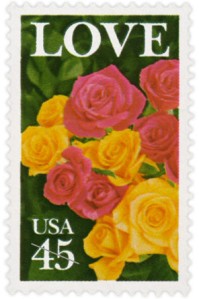Roses grace both Love stamps issued in 1988, but for those in the know, the message the stamps send to their recipients could be subtly but clearly different.
![PinkFlowr25_sglG_4x_BGv1 [Converted]](http://uspsstampsblogs.files.wordpress.com/2013/01/love-25-cent.jpg?w=264&h=300) The 25-cent stamp (issued on July 4, 1988, at the Rose Bowl no less) depicts a single pink rose. Pink roses indicate love and gratitude, but the nuance of the message changes with the hue. One light pink rose can signify sympathy, but also happiness and admiration for the recipient. A rose of dark pink means “thank you.” A thornless pink rose can indicate love at first sight, while pink rosebuds denote a happy heart. The lovely bloom on this stamp could mean joy in the relationship with the recipient.
The 25-cent stamp (issued on July 4, 1988, at the Rose Bowl no less) depicts a single pink rose. Pink roses indicate love and gratitude, but the nuance of the message changes with the hue. One light pink rose can signify sympathy, but also happiness and admiration for the recipient. A rose of dark pink means “thank you.” A thornless pink rose can indicate love at first sight, while pink rosebuds denote a happy heart. The lovely bloom on this stamp could mean joy in the relationship with the recipient.
The 45-cent stamp (issued on August 8, 1988) features a full bouquet of yellow and red blossoms. For Victorians, yellow roses could indicate a decrease in affection or even jealously. Today, however,  yellow roses are the flower of choice to denote friendship and joy. Combined in a bouquet with red roses, the message is one of happiness and celebration—joyous love, even.
yellow roses are the flower of choice to denote friendship and joy. Combined in a bouquet with red roses, the message is one of happiness and celebration—joyous love, even.
Floriography—the language of flowers—is beautiful but complex. Colors and combinations of flowers and foliage can be deciphered in several ways, as each component might carry more than one meaning that changes over time. Even the number of flowers in a bouquet has significance. A bouquet of ten roses in any color combination, for example, can mean, “You are perfect.”
You may be wondering why we issued two Love stamps at two different rates in 1988. The 45-cent stamp was added to the program to meet the demand for stamps that could be used to mail wedding invitations, which typically weigh more than one ounce.
To learn more about the language of flowers, consult any number of flower dictionaries available online.
